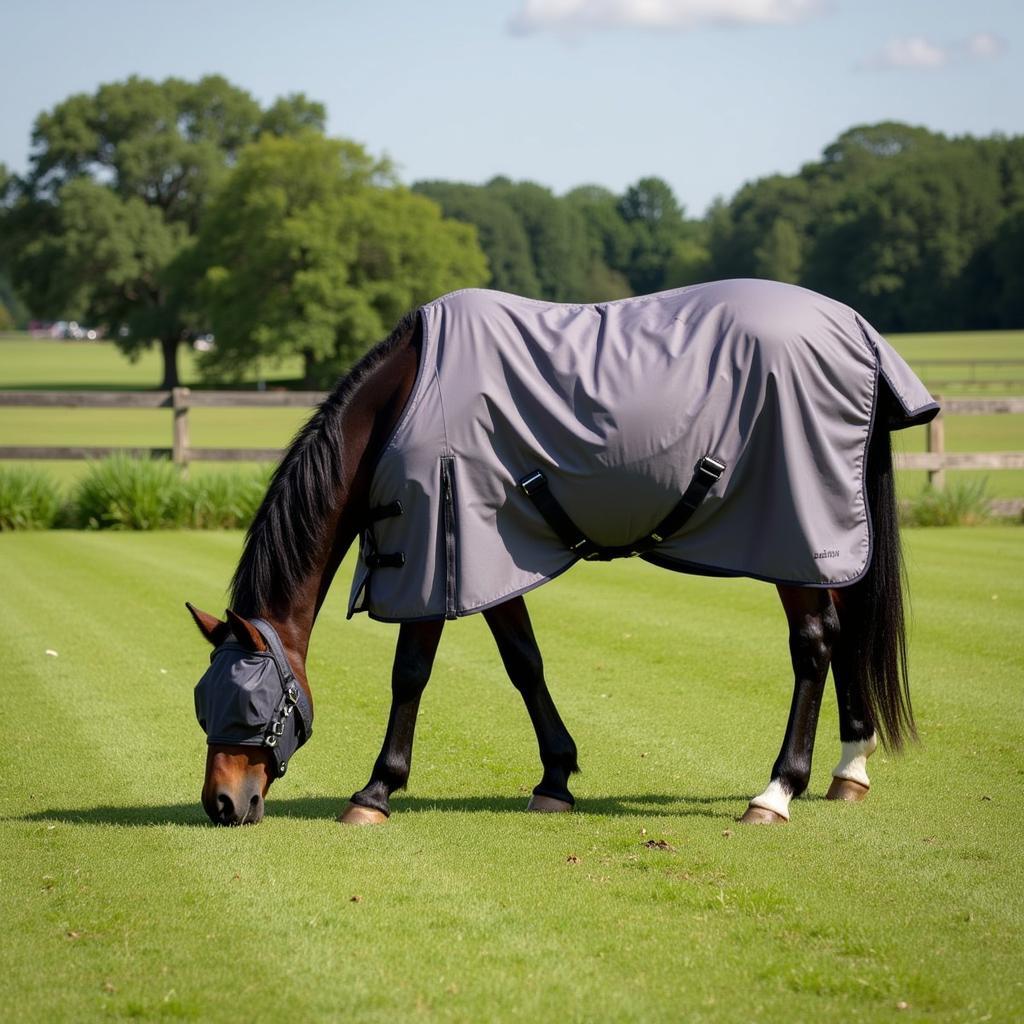Swat Horse Ointment is a popular choice for horse owners seeking relief for their animals from biting flies and other pesky insects. Understanding how to effectively use swat, alongside other preventative measures, is crucial for maintaining your horse’s comfort and health throughout the fly season. This comprehensive guide will delve into the benefits, application, and considerations for using swat horse ointment, empowering you to make informed decisions for your equine companion.
Understanding the Need for Swat Horse Ointment
Flies are more than just a nuisance; they can transmit diseases, cause painful bites, and lead to significant stress for horses. Swat ointment for horses offers a protective barrier against these insects, allowing your horse to graze peacefully and enjoy their time outdoors. From common house flies and stable flies to the more aggressive horse flies and deer flies, choosing the right fly repellent is a vital part of responsible horse ownership.
Protecting your horse from flies isn’t just about comfort; it’s about preventing potential health issues. Insect bites can become infected, leading to discomfort and costly veterinary bills. Furthermore, constant irritation from flies can cause horses to become agitated and stressed, impacting their overall well-being.
Choosing the right fly repellent can be overwhelming. There are sprays, wipes, roll-ons, and ointments, each with its own advantages and disadvantages. Understanding the specific needs of your horse, the severity of the fly problem in your area, and the ingredients in each product will help you make the best decision.
 Applying Swat Horse Ointment to a Horse's Legs
Applying Swat Horse Ointment to a Horse's Legs
Choosing the Right Swat Horse Ointment
Not all swat horse ointments are created equal. Look for products that contain effective ingredients known to repel flies and other biting insects. Consider the duration of protection offered, as some ointments provide longer-lasting relief than others. Also, be mindful of your horse’s skin sensitivity and choose a formula that is gentle and non-irritating.
Reading reviews from other horse owners can be invaluable in your decision-making process. Look for real-world experiences and feedback on the effectiveness of different swat ointments. This can provide practical insights and help you choose a product that truly delivers on its promises.
Swat horse products are a popular choice among horse owners. They are generally effective and offer a good balance of protection and affordability. However, like any product, it’s important to read the label carefully and follow the instructions for proper application.
 Horse Fly Prevention Strategies
Horse Fly Prevention Strategies
Applying Swat Horse Ointment Effectively
For optimal protection, apply horse ointment cream to clean, dry skin. Focus on areas where flies tend to congregate, such as the face, ears, legs, and belly. Avoid applying the ointment to open wounds or irritated skin. Always follow the manufacturer’s instructions for the specific product you are using.
How often you need to reapply swat horse ointment depends on several factors, including the severity of the fly problem, the weather conditions, and the specific product you are using. In general, it’s a good idea to reapply the ointment every few days or as needed.
“Regular application of a quality swat ointment is a cornerstone of fly control,” says Dr. Emily Carter, DVM. “It’s a simple yet effective way to protect your horse from the discomfort and potential health risks associated with biting insects.”
Beyond Swat: Holistic Fly Control for Horses
While swat horse ointment plays a significant role in fly control, it’s most effective when used as part of a comprehensive strategy. Consider incorporating other preventative measures, such as fly masks, fly sheets, and stable management practices.
Natural mosquito repellent for horses can be a good option for horses with sensitive skin. These repellents often contain essential oils and other natural ingredients that are gentle yet effective.
“Don’t underestimate the power of good stable management,” advises renowned equine behaviorist Sarah Miller. “Regular cleaning of stalls, manure management, and proper drainage can significantly reduce fly populations around your barn.”
 Comparing Different Fly Repellents
Comparing Different Fly Repellents
Conclusion: Keeping Your Horse Fly-Free with Swat Horse Ointment
Swat horse ointment is a valuable tool in your arsenal against biting flies. By understanding how to choose and apply it effectively, and by incorporating other preventative measures, you can ensure your horse remains comfortable and healthy throughout the fly season. Remember to always prioritize your horse’s well-being and consult with a veterinarian if you have any concerns.
FAQ
- How often should I apply swat horse ointment?
- Can I use swat ointment on my horse’s face?
- Are there natural alternatives to swat ointment?
- How can I prevent flies in my horse’s stable?
- What are the signs of a fly bite reaction in horses?
- Is swat ointment safe for all horses?
- What should I do if my horse ingests swat ointment?
Do you have more questions regarding spray for horse flies or related topics?
For further assistance, contact us at Phone: 0772127271, Email: [email protected] or visit our location at QGM2+WX2, Vị Trung, Vị Thuỷ, Hậu Giang, Việt Nam. Our customer service team is available 24/7.